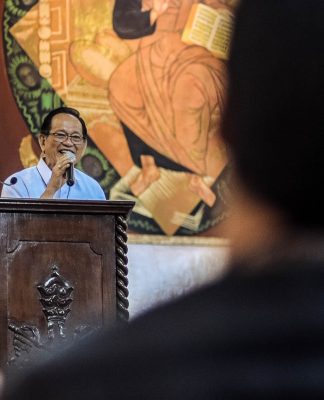THE UNIVERSITY’s two high schools placed second and third among Manila-based schools in the National Achievement Test (NAT) last year, under a new ranking system implemented by the Department of Education (DepEd).
Public and private high schools were grouped together depending on the number of examinees, following complaints over a supposedly “unfair” system of ranking schools.
Fielding 96 examinees, the UST Education High School (EHS) ranked second out of the 15 schools in cluster four, or schools with 55 to 99 examinees.
“[The results] show that in some subjects, we [received] higher [grades] compared with the school that ranked first [but], when it came to Science and Math, mas mataas sila,” said EHS Principal Loreto Sauz.
The Malayan High School of Science in Pandacan, Manila, which fielded 76 examinees, emerged as the top school in the cluster with 65.42 percent, a few notches over EHS’s 63.65 percent.
Other schools in the cluster include Uno High School (3rd), O.B. Montessori Center (4th), Philippine Cultural High School (5th), Concordia College (6th), College of the Holy Spirit-Manila (7th), Don Bosco School (Salesian Sisters) Inc. (8th), La Consolacion College (9th), Nazareth School (10th), Sta. Catalina College (11th), National University (12th), St. Mary’s Academy-Sta. Ana (13th), St. Francis School (14th) and St. Joseph School of Pandacan (15th).
EHS, however, topped other schools in the cluster in the Critical Thinking (74.01 percent), Araling Panlipunan (70.21 percent), and Filipino (64.15 percent) subjects.
English was the highest score of the University’s laboratory school, at 76.41 percent. But EHS got only 47.93 percent in Science and 54.56 percent in Mathematics.
Meanwhile, the UST High School (USTHS) scored 57.01 percent to finish third in cluster two, or those that fielded 200 to 399 examinees, trailing behind first-placer St. Jude Catholic School that scored 67.91 percent and St. Scholastica’s College-Manila that got 60.62 percent.
In all six NAT subjects, USTHS obtained its highest score in English, at 68 percent. USTHS Principal Marishirl Tropicales attributed the score to the “natural spiral approach” in teaching the subject.
“We always revisit the same topic [in English] but in different complexity,” she said.
USTHS also scored lowest in Science with 45.12 percent. Tropicales said the “compartmentalized structure” of teaching Science affected the score.
USTHS secretary Emmanuel Batulan agreed and said they would have to revise the sequencing of topics in Science.
“Topics that were included in the [NAT] are usually tackled in the latter part of the school year,” he said.
USTHS got 65.72 percent in Critical Thinking, 61.34 percent in Araling Panlipunan, 54.12 percent in Filipino, and 52.74 percent in Mathematics.
Other schools in the Top 10 were Chiang Kai Shek College (4th), Malate Catholic School (5th), National Teacher’s College (6th), Holy Trinity Academy (7th), Espiritu Santo Parochial School (8th), Manila Cathedral School (9th) and Holy Child Catholic School (10th).
‘So-so performance’
Tropicales said she was “not so happy” with the “average” performance of USTHS.
Out of 11,884 high schools in Manila, both high schools of the University fell under the average (35 to 65 percent) bracket.
“We are hoping that next time, we will enter the ‘moving towards mastery’ bracket since most of [our] subjects in the NAT were rated as such,” she said.
A total of 658 schools belonged to the “moving towards mastery” level, or those having a 66 to 85-percent mark. One school reached the “closely approximating mastery” (86 to 85 percent) rank while 520 schools were considered as having “low” mastery, or those with scores of 15 to 34 percent.
Last March, 6,640 Thomasian high school students took the NAT exams.
In 2008, the NAT was administered for the first time to second-year high school students to assess their aptitude in five basic subjects.
But DepEd, through memorandum No. 226 series of 2011, decided to administer the exams anew to fourth-year high school students last school year to “monitor the public education system and schools for public accountability, identify instructional practices, measure student achievement, and evaluate student’s mastery skills.” Cez Mariela Teresa G. Verzosa














